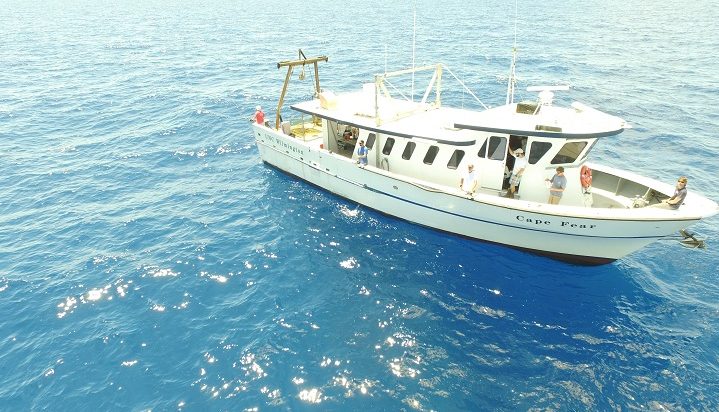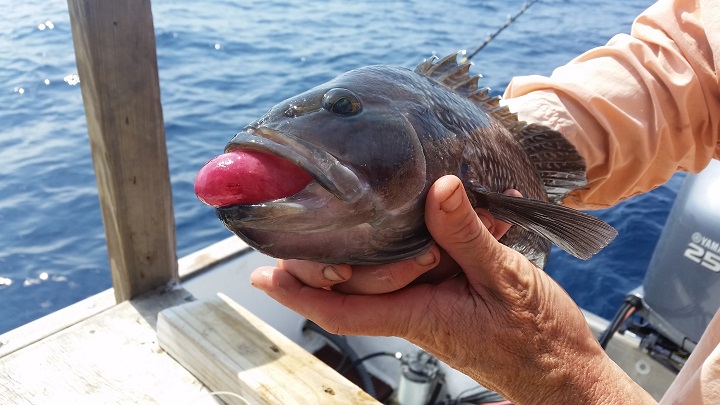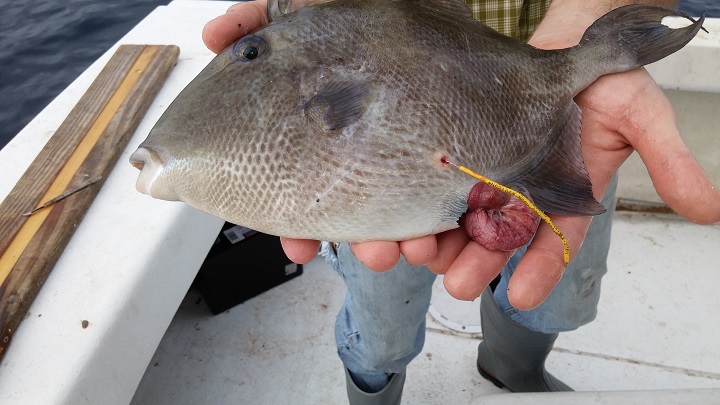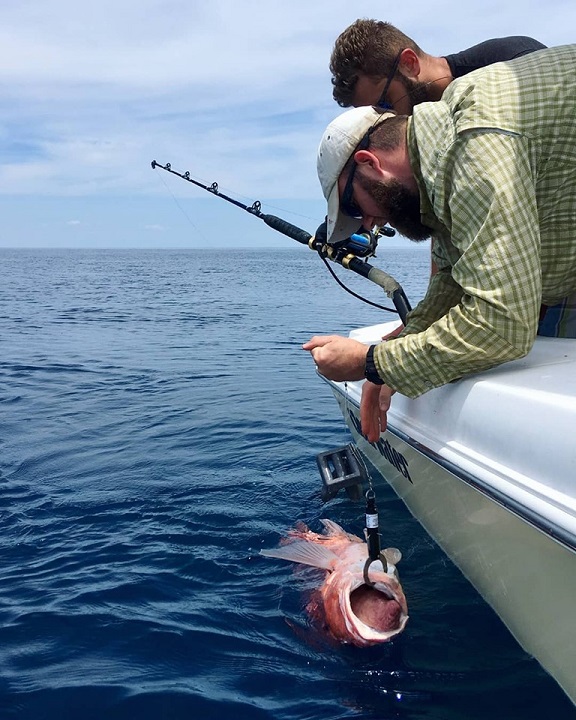
After hooking a fish, reeling it in from the sea floor and posing for a photo, there’s a fairly good chance a recreational fisher might release their catch back into the ocean. The chance of that fish’s survival is less clear.
Rising numbers of released fish, combined with an uncertain likelihood of their survival, has made it more challenging to estimate how many fish die after release, which is a crucial factor considered when creating fishing regulations.
Supporter Spotlight
Researchers at North Carolina State University’s Center for Marine Science and Technology, or CMAST, have been studying the fate of released fish, called discards, to more accurately estimate death rates from fishing and to improve survival of discards.
Over the past few years, they’ve determined discard survival likelihood for several deep fish species. They’ve also confirmed that helping a fish get back to deep water, through strategies like venting and recompression, significantly increases a fish’s chance of survival.
Deepwater fish live under pressure. The pressure at 90 feet underwater is almost four times greater than at sea level. When fish from about that depth or deeper are brought to the surface, the sudden drop in pressure can lead to injuries called barotrauma.
Barotrauma looks extremely uncomfortable. The gas inside a fish’s swim bladder, an internal organ that helps them float, expands and can even push other organs out of the fish’s mouth. The fish’s eyes may bulge out of its head. A bloated swim bladder can also act like swim floaties, preventing the fish from returning to deeper water when it’s released. That fish might die at the surface or a predator might pick it off.

An angler might discard a fish if they don’t want to keep it or if it doesn’t meet regulations, such as a size limit, catch limit or closed season. Over the past 20 years, discarded black sea bass in the US Atlantic and Gulf of Mexico fisheries have outnumbered those brought to shore. In recent years, gray triggerfish discards have been two to three times higher than the number kept. This overall increase is probably from a mix of increased fishing effort, such as number of boats and amount of time spent on the water, and changes in regulations that dictate which fish can be kept.
Supporter Spotlight
About 15 years ago, this increase in discarded black sea bass began to concern Jeff Buckel, a professor at CMAST. Buckel is on the Scientific and Statistical Committee of the South Atlantic Fishery Management Council, or SAFMC, the agency that sets fishing regulations in waters between three to 200 nautical miles off the shores of North Carolina to Florida.
Buckel saw firsthand how uncertainty in survival rates of discarded fish translated into uncertainty in the conservation of these species.
Since then, Buckel’s research group has studied discarded fish off the coast of North Carolina to help improve fisheries management.
Their experiments begin by catching fish, often hundreds to thousands of them per experiment.
Senior research scholar Paul Rudershausen, doctoral candidate Brendan Runde, and others in the Buckel group have conducted experiments with species such as black sea bass, gray triggerfish, scamp, snowy grouper, speckled hind, dolphinfish and cobia.
“Our work on discard mortality would not have been possible without the knowledge and collaboration of both commercial and recreational fishermen,” noted Rudershausen.
Once a fish is caught, they check for any signs of barotrauma, attach a tag or transmitter to the outside of the fish, and then release the fish back into the ocean. Importantly, they also dive to the sea floor to tag fish that haven’t been brought to the surface, for comparison.

In experiments with tagged fish, the researchers go offshore several more times to see which fish they catch again. If other fishers catch the tagged fish, they can phone in to report a number on the tag. The percent of discarded fish that they recapture, compared to the percent of fish tagged on the sea floor that they recapture, can provide insight on discard survival. Roughly a quarter of all tagged fish in their experiments are recaptured in the days to years after being tagged.
For fish with attached transmitters, the researchers can retrieve data from receivers they deploy at the sea floor, which can track a fish’s movement. If a fish stops moving, it’s presumed dead.
The researchers use their experimental data in statistical models to estimate survival rates of released fish.
In an earlier study published in 2014, they found that black sea bass with barotrauma actually had a good chance of surviving, about 90%, if the fish were still able to swim back underwater and didn’t have a hook injury. However, fish with barotrauma that floated after release had just a 16% likelihood of surviving.
In a follow-up study published in 2019, they tested whether helping released fish get back underwater, either by venting or using a descending device, could increase survival.
Venting involves puncturing a fish’s bloated swim bladder with a hollow needle to release the gas, so the fish won’t float. Descending devices are weighted hooks or clips that a fisher attaches to the caught fish. The clip releases the fish once it’s back to its normal depth, and the fisher can reuse the descending device.
For black sea bass, both venting and descending devices were equally effective and improved survival likelihood.
Sometimes the researchers’ results differ from what was previously thought. For example, all deepwater grouper discards are expected to die of barotrauma, since they typically live more than 200 feet underwater. However, Runde discovered about half of released deepwater groupers will survive if they’re released with a descending device. Though not all the fish survive, the jump from none to half is huge.
The researchers also found that survival rates for released gray triggerfish were lower than expected. After a three-year study published in 2019, they found that released fish with no visible injuries had just a 40% estimated chance of survival. For fish with barotrauma, there was no chance of survival if they floated and about a 25% chance if they could get back underwater.
These findings highlight differences between fish species, which are why management strategies are customized.
Newfound discard survival rates found by the CMAST group, as well as by other researchers, will be considered in future fish stock assessments to improve how fisheries are managed. Stock assessments use mathematical models to estimate the population size and death rates of a fish species in a certain region, like the US South Atlantic.
“You need estimates of release mortality to really assess these species properly,” said Chip Collier, deputy director for Science and Statistics at SAFMC. “The Buckel Lab’s work has been extremely beneficial in figuring out ways to improve survivorship in the fishery.”
Their research on the effectiveness of descending devices has also contributed to an amendment that requires boats fishing for snapper or grouper species to carry descending devices that are ready to use. In September 2019 the SAFMC approved the amendment for the US South Atlantic, and in January submitted it for review on a national level.
“Research from the Buckel Lab, along with many others, has been instrumental in the development of regulations related to recompression tools such as descending devices,” commented Christina Wiegand, a fishery social scientist with SAFMC.
The descending device regulation is a major step forward, but requiring these devices on boats doesn’t necessarily mean people will use them. Buckel still meets fishers who haven’t heard of the devices. A cultural shift is needed so that fishers feel responsible for properly releasing fish that show signs of barotrauma.
“In my opinion, the way to do it is through education and outreach,” said Runde. Through a grant from the South Carolina Wildlife Federation, he’s taught local fishers about using descending devices and has handed out over 100 free devices.

Venting tools are still more widespread than descending devices. While venting is convenient and effective when done properly for species like black sea bass, descending devices are needed for larger and deeper species, noted Buckel.
Some descenders can cost above $50, but fishers can also make their own for much cheaper. A weighted milk crate placed on the bloated fish can descend the fish to deeper waters until it recompresses and swims away.
Runde recommends taking at least eight pounds of weight to be prepared for descending large fish. Prepping the device beforehand is also crucial to minimize time the fish spends at the surface.
Fishers can learn more by taking a quick online tutorial from the SAFMC. Many how-to videos are also available online that describe specific descender devices.
Effective management, along with tools that help discarded fish get back to deep water, can improve fishers’ chances of encountering these fish for decades to come.








